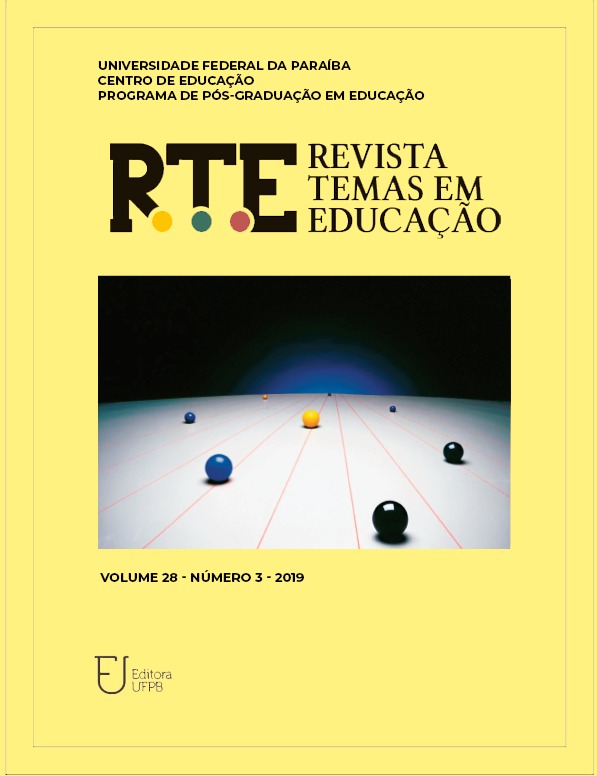AN IMMERSION IN CHAOS: SITUATED PEDAGOGY AND AUDIOVISUAL PRODUCTION WITH CHILDREN IN SCHOO
AN IMMERSION IN CHAOS: SITUATED PEDAGOGY AND AUDIOVISUAL PRODUCTION WITH CHILDREN IN SCHOOL
DOI:
https://doi.org/10.22478/ufpb.2359-7003.2019v28n3.48521Keywords:
Situated pedagogy, Ecosystem paradigm, Audio-visual, ChaosAbstract
The text aims to reflect on elements such as unpredictability, order-disorder and collaboration at the time of pedagogical action when it is proposed based on the active methodology. Therefore, didactic situations of audiovisual production were created that intended to displace the “places of knowledge”, without privileging neither the teacher nor the student in the classroom, but focusing on their relationships. Based on a qualitative doctoral research conducted with elementary school children from two public schools, the discussion adopts the ecosystemic perspective of education and communication, and approaches the systemic perspective of chaos applied to education, to consider the body, interactions and context as key elements of a situated pedagogy. The results show that non-centrality (teacher or student) and openness to the double movement of order-disorder shook the whole structure of the classroom creating “chaos”.
Downloads
References
AKMANSOY, Vesile; KARTAL, Sadık. Chaos Theory and its Application to Education: Mehmet Akif Ersoy University Case. Educational Sciences: Theory & Practice. 14(2), p. 510-518, 2014
BANNELL, Ralph. Uma faca de dois gumes. In FERREIRA, Giselle Martins dos Santos. Educação e Tecnologia: abordagens críticas. Rio de Janeiro: SESES, 2017. p.: 17-60
BATESON, Gregory. Una unidad sagrada. Passos ulteriores hacia una ecologia de la mente. Barcelona: Gedisa, 1993
BERTHOZ, Alain. La Simplexité. Paris: Odile Jacob, 2009
COLOM CAÑELLAS Antonio J. Teoría del caos y educación (Acerca de la reconceptualización del saber educativo). Revista Española de Pedagogía, Vol. 59, No. 218 (enero-abril 2001), pp. 5-24
CHRISTENSEN, Pia. Lugar, espaço e conhecimento: crianças em pequenas e grandes cidades. In, MULLER, Fernanda (org). Infância em perspectiva: políticas, pesquisa e instituições. São Paulo: Cortez, 2010. P. 143-164
FOWLER, Stuart; WALT, Johannes L. Van Der. Chaos and order in education. South African Journal of Education, vol 24(1) 64 – 69, 2004
HOBBS, Renee. Create to Learn. Introduction to Digital Literacy. New Jersey: Wiley- Blackwell, 2017
MIRANDA, Lyana Virgínia Thédiga. Saberes de ação, interação e comunicação: metodologia ativa e resolução colaborativa de problemas com crianças na escola. Tese (Doutorado), Programa de Pós- Graduação em Educação, Universidade Federal de Santa Catarina, 2016.
MIRANDA, Lyana Virgínia Thédiga; FANTIN, Monica. A perspectiva social das competências midiáticas: reflexões sobre participação e interação das crianças na escola. Lumina - Revista do Programa de Pós-graduação em Comunicação. Juiz de Fora, PPGCOM – UFJF, v. 12, n. 1, p.55-67, jan./abr. 2018
MIRANDA, Lyana Virgínia Thédiga. Sala de aula “expandida”: multiliteracies, múltiplas linguagens e multissensorialidades no uso das tecnologias móveis pelas crianças na escola. Revista Educação Online, Rio de Janeiro, n. 28, mai-ago 2018, p.83-107
MUCCHIELLI, Alex. Étude des communications : nouvelles approaches. Armand Colin, Paris, 2006
MORONI, Juliana; GONZALEZ, Maria Eunice Quilici; MORAES, João Antonio. O que é filosofia ecológica? Kínesis, Vol. III, n° 05, Julho-2011, p. 349-355.
MORIN, Edgar; LE MOIGNE, Jean-Louis. A Inteligência da Complexidade. São Paulo: Petrópolis, 2000.
PISCHETOLA, Magda; MIRANDA, Lyana Thédiga de. A sala de aula como ecossistema. Tecnologias, complexidade e novos olhares para a educação. Rio de Janeiro: Editora PUC-Rio, 2019
PRADO, Magaly. Aprendizagem ativa conectada em meio ao caos do estudante-ator-rede. Comunicação & Educação, Ano XXIII, número 2, jul/dez, 2018
RIVOLTELLA, Pier Cesare. Fare Didattica con gli EAS. Episodi di Aprendimento Situati. Brescia: La Scuola, 2013.
SIBILIO, Maurizio. Il corpo inteligente. Naples: Simone, 2002
Downloads
Published
How to Cite
Issue
Section
License
Authors who publish in this journal agree to the following terms:
. Authors retain the copyright and grant the journal the right to first publication, with the work simultaneously licensed under the Licença Creative Commons Attribution that allows the sharing of the work with acknowledgment of authorship and initial publication in this magazine. . Authors are authorized to assume additional contracts separately, for non-exclusive distribution of the version of the work published in this journal (eg, publishing in institutional repository or as a book chapter), with acknowledgment of authorship and initial publication in this journal.
. Authors are permitted and encouraged to publish and distribute their work online (eg in institutional repositories or on their personal page) at any point before or during the editorial process, as this can generate productive changes, as well as increase impact and citation of the published work (See O Efeito do Acesso Livre).



















